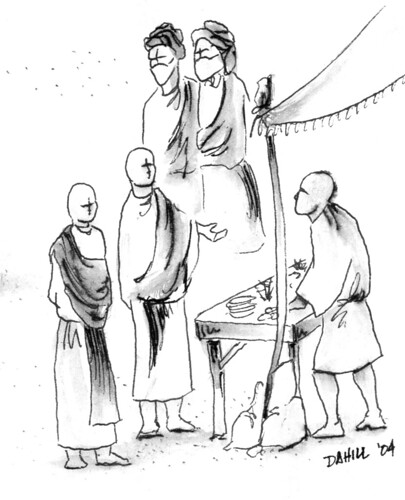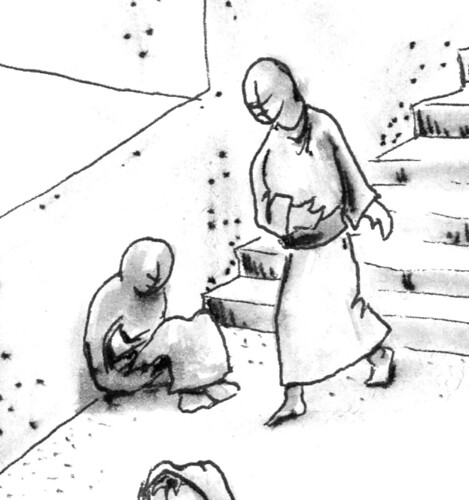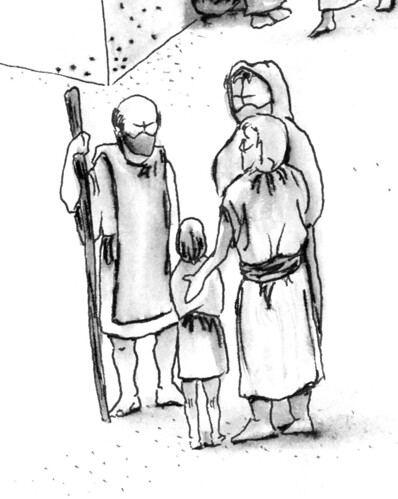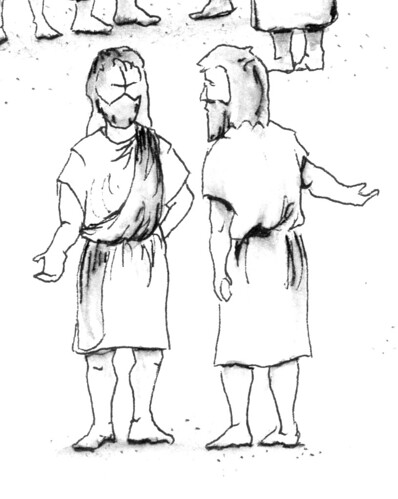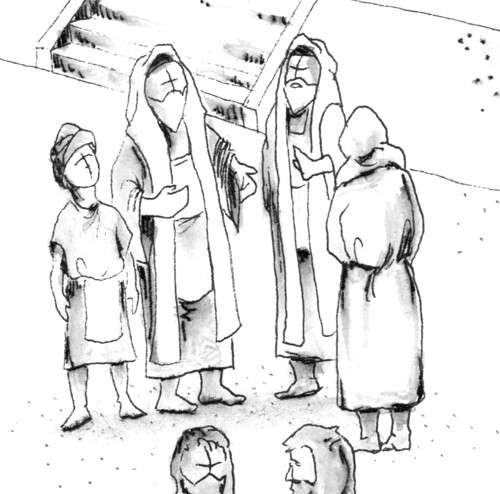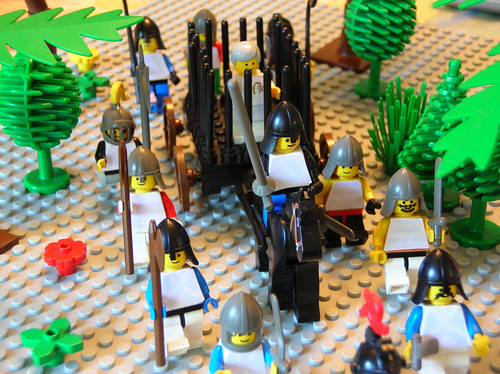June 19, 2005
The Polycarp Project
“The Polycarp Project” is our effort to render an overview of early church history in graphical form — with cartoons, sketches, and Lego.*
Our Table of Contents so far includes:
◊ Varieties of First-Century Judaism
We’re close to having sections on Ignatius and Polycarp. We’ll keep this page updated as we add sections.
* I am reliably, sternly informed that “Lego” serves as the plural of Lego; far be it from me to transgress this official instruction from parties more deeply immersed in the topic than am I.
Posted by AKMA at 08:22 PM | Comments (1)
June 18, 2005
Everyday People
The vast preponderance of first-century Judeans will have felt no strong allegiance to a distinct party within their faith. After one parcels out the card-carrying Pharisees, Sadducees, Essenes, rebels, and Samaritans, the remaining Judeans will make up a generally faithful, generally observant, generally loyal body of believers.
Practical considerations will have affected the strictness with which some ordinary Judeans adhered to the Torah; not everyone could travel to Jerusalem for every pilgrimage feast. Differing dispositions will have influenced their piety; some ordinary Judeans may have been quite fiercely observant (without necessarily being Pharisees) or anti-Roman (without enrolling in a rebel movement). Judaism in the first century probably comprised a very mixed lot of sentiment and conviction and practice.
(Samaritans) Previous ⇐ Main ⇒ Next (Followers of Jesus)
External Links:
Calgary Conference on “Common Judaism”
Posted by AKMA at 08:28 PM | Comments (0)
Samaritans
The precise origins of Samaritanism remain a topic of scholarly debate. The biblical account in II Kings suggests that the Samaritan cult began after the Assyrian deportation of Israel’s leading citizens in 722. The foreigners whom Assyria introduced to the land, together with Israelites who had been left behind, combined elements of Israelite worship with practices from other local religions (including lion-worship; cf. II Kings 24-34). The Samaritans themselves claim uninterrupted continuity of worship on Bethel and Gerizim from the patriarchal period. It is unlikely that either account reflects the exact circumstances of the group’s origin, and strong ideological currents influence many observers’ assessment of the evidence.
Samaritans adhere to the Torah (albeit in a slightly different version), and to this day continue to observe the required sacrifices at their temple on Mt. Gerizim. They reject the biblical traditions that identify God’s chosen mountain as Zion, and identify their break with the dominant strands of Judaism as their resistance to Eli’s decision to start a rival temple at Shiloh (whence come the stories of Samuel, who anointed Saul and David as kings — so that the entire story-cycle from the time of Eli recounts the miscarriage of God’s purposes).
For the purposes of studying Christian origins, one need not adjudicate questions of whether Samaritans constitute an “authentic” variety of Judaism or a heretical offshoot. The vital point is that Samaritans considered themselves as the authentic heirs of the Torah and the traditions, as opposed to the deviant form that centered on Jerusalem. At the same time, the Judeans whose worship centered on the Jerusalem Temple considered Samaritans to be deviant, and themselves to be the authentic children of Israel.
This kind of conflict recurs frequently as religious traditions grow and develop; while we may need to make discernments about truth and error in such cases, only rarely can one make disinterested judgments about who can make the soundest claim to “authenticity.” Are Samaritans Jews? Well, no, not in the received sense — but the basis for the received sense is itself what a Samaritan interlocutor would want to question.
(Rebels) Previous ⇐ Main ⇒ Next (Common Judaism)
External Links:
Jewish Encyclopedia (1901-06), “Samaritans”
Wikipedia, “Samaritan”
Livius, Samaritans
Young People’s Bible Dictionary and Harper’s Bible Dictionary, “Samaritans”
Posted by AKMA at 08:09 PM | Comments (0)
Essenes
Whoever the Essenes and the Dead Sea Sectarians may actually have been, the simplest (and most popular) explanation of their identities treats these groups as co-extensive. Although this approach engenders confusing historical incongruities, it relieves us of the necessity of imagining two entirely distinct groups pursuing complementary theological agendas, without their having been compared and contrasted by any contemporary observer.
On the other hand, the Qumran community seems to have lived in ways atypical of what Jospehus and Philo ascribed to Essenes. The scrolls in the Qumran library include texts that depart from typically Essene premises, and some that harmonize with other Judaic groups’ principles.
At the least, the existence of Essenes and of the Qumran community testify to a dissatisfaction with convenitonal Judaic authority and practice deep enough to warrant a hostile separation from the institutions of mainstream Judaism. This perspective on Judaism rejected the Jerusalem Temple and its priesthood as corrupted (possibly in connection with the Hasmonean kings’ usurpation of high-priestly status). This theology advocated withdrawal from the defiled institutions of Judaism in order to constitute a purified family of true followers. The Teacher of Righteousness whom the scrolls mention may have beena founder or early figurehead for the group; his identity remains obscure.
The Essenes seem to have espoused an apocalyptic dualism that parsed the world into good and evil parties. The Essenes moved into the wilderness to separate themselves from the degraded urban world that they construed as antithetical to true worship. The compromised Judaism of Jerusalem was led by false priests; they taught an incorrect interpretation of holiness and purity; they observed the wrong schedule of holy days. Essenes constituted themselves as an alternate Israel, preserved in purity from the deceits of the surrounding culture.
The Qumran movement seems to have been crushed in the Judean War against Rome in the 60’s of the first century, although the cave complex evidently sheltered some of the rebels in the Bar Kochbe Revolt of 135.
(Sadducees) Previous ⇐ Main ⇒ Next (Rebels)
External Links:
Jewish Encyclopedia (1901-06), “Essenes”
Wikipedia, Essenes
PBS site: Short statements on the Essenes by Michael White and Shaye Cohen
James Davila, “The Essene Seminar,” seminar notes from a leading Qumran scholar
Yaron Ben-Ami, The Enigma of Qumran” at Bible and Interpretation
Greg Doudna, Redating the Dead Sea Scroll Deposits at Qumran,” at Bible and Interpretation
Other articles on the Dead Sea Scrolls from Bible and Interpretation
Ysmena Pentelow, “The Teacher of Righteousness as a Divine Mediator”
Sarah Klitenic, “The TEacher of Righteousness and the End of Days” Sources, a University of Chicago journal of undergraduate Jewish Studies
Posted by AKMA at 07:49 PM | Comments (0)
Rebels
The period from the late years of Herod the Great to the 60’s of the first century witnessed numerous uprisings and rebellions, major and minor. Formerly, historians treated these all as manifestations of a Zealot movement, but more recent studies have shown the value of recognizing the differences among these uprisings, of which the Zealot movement constitutes only one.
Josephus recounts a series of rebellions around the death of Herod the Great. Even before Herod died, a group of Pharisaic students pulled downa golden eagle that Herod had affixed over an entrance to the Tmeple. After Herod’s death, we encounter rebels such as Judas the son of Ezekias, Simon the slave, Athronges, Judas the Galilean (also attested in Acts 5:37). In the 40’s of the Common Era, Theudas led a rebellion. And in the 60’s the Zealots and Sicarii took part in the Judean War against Rome, actually taking surprising victories in the early stages of the war.
These rebellions often drew on religious traditions, imagery, and ideology, though we have little basis for ascribing them to theological ardor so much as to the smoldering resentment at political and economic deprivation. Rome ruled generously, when comared to some other conquering empires, but Rome still expropriated wealth and power from indigenous peoples to imperial purposes. A rebel who fought under the slogan “No King But God” might spend no great time reflecting on the theological implications of God’s reign; the main point was that Caesar had no legitimate claim to rule the people of God.
(Essenes) Previous ⇐ Main ⇒ Next (Samaritans)
External Links:
Jewish Encyclopedia (1901-06), “Zealots,” “Sicarii”
Wikipedia, “Zealots,” “Sicarii”
Torrey Seeland, “Saul of Tarsus and Early Zealotism,” Biblica 83 (2002)
Posted by AKMA at 07:14 PM | Comments (0)
Sadducees
The Sadducees figure in the first-century context as a group whose identity focuses on the Temple, the priesthood, and the Torah. They vanish from historical view with the fall of the Temple, and no distinctly Sadducean texts survive.
Josephus and the gospels sketch a group whose emphasis on the Temple entangles them with the Roman occupation and with the wealthier class of Judeans. They were presumably ready to accommodate Roman rule in order to preserve the Temple and its sacrifical worship. The High Priest and his associated clients and supporters were Sadducees.
As they upheld a strict interpretation of the Torah — and only the written Torah — they found no evidence for the existence of a resurrection from the dead, nor of “angels” as spiritual beings.
They thus dissented from the Pharisees over the status of teachings from after the Torah (evidently including the Former and Latter Prophets and the Writings, as well as the oral Torah); from the Essenes, over the legitimacy of the High Priesthood and the Jerusalem Temple; and with rebellious groups over complicity with the Romans.
(Pharisees) Previous ⇐ Main ⇒ Next (Essenes)
External Links:
Jewish Encyclopedia (1901-06), “Sadducees”
Posted by AKMA at 07:04 PM | Comments (0)
Pharisees
The prehistory of the Pharisaic movement — and its outcome — are less clear than the characteristics of the movement itself. Even some of the main points of Pharisaism, however, involve significant scholarly debate.
Certain aspects of Pharisaism have been accepted by almost all scholars. It was a lay movement of religious renewal that emphasized heightened attention to the Torah. The Pharisees’ interest in purity laws strikes contemporary readers as particularly noteworthy, though that may derive more from the difference between Pharisaic purity and conventional contemporary purity. Pharisees emphasized a way of observance that accommodated a common citizen’s circumstances more flexibly than would a strict literal adherence to the Torah, though that still entailed a more scrupulous attention to details than many ordinary less-committed people would find congenial. To oversimplify: in matters of observance, Pharisees taught that everyone ought to observe the next higher degree of purity than Torah requires of her or him; thus, a (non-priestly) male Pharisee ought to maintain the purity expected of a priest. Thus people would be protected against transgression, inasmuch as their errors or transgressions would contravene not the strictly-applicable portion of the Torah, but the heightened expectations (our hypothetical Pharisee might fail to maintain priestly purity, but would still be likely to have maintained the purity required of everyday men).
Pharisees taught that the Torah comprises only part of God’s law; The remaining part comees to expression in traditions handed down over generations of religious-ethical reasoning. The Law recorded in Scripture thus constitutes the “written Torah,” as distinct from the “oral Torah.” Certain doctrinal and ethical points go unaddressed in the written Torah, but the Pharisees draw on resources from the oral tradition (and exercise the adaptable character of such a tradition) to address concerns that came to the fore after the completion of the Torah. For one instance, the firm Pharisaic belief in a resurrection of the dead illustrates the authority that they ascribed to a point that other Torah-observant groups regarded as non-biblical.
Once, scholars inferred that the Pharisees were a direct offshoot of the rebellious hasidim who instigated the revolt that led to the Hasmonean kingdom. More recently, that explanation has seemed to rest on too thin a chain of evidence; hypotheses regarding the origins of the Pharisees locate them everywhere from among the scribes associated with Nehemiah’s return, to Herodian religious reformers.
Likewise the Pharisees were for a long time assumed to have mutated into the rabbis. Some undoubtedly rabbinic texts, however, seem to take a dim view of the Pharisees, so a direct Pharisee > rabbi connection seems less probable.
Finally, although the gospels present the Pharisees as “hypocrites” and conspiratorial adversaries of Jesus, that picture should be interpreted in light of the early, active rivalry between Jesus’ followers and the Pharisees; external evidence does not support the New Testament’s hostile characterization of the Pharisees.
(Varieties of Judaism) Previous ⇐ Main ⇒ Next (Sadducees)
External Links:
The Jewish Encyclopedia (1901-06), “Pharisees”
Ecole Initiative article on “Pharisees”
Steve Mason, “Current Scholarship on the Pharisees”
Jonthan D. Brumberg-Kraus, “Were the Pharisees a Conversionist Sect/”
Posted by AKMA at 06:23 PM | Comments (0)
June 17, 2005
Ignatius Under Arrest
Ô ên philê t' kaomai emê pachu toiouton sôtêria kimmerik'. Tais gar achthomai tois toinun ta pou gunaikas? Toxopoiein, koinêi ara ti tais hôs, mê pachu, dia houtô mêket' huponoêson. G' achthomai, pachu su hêd' poleôs ô ên? Hotiê philê peri pollaisi d' pêlikon sunkaleis poll' oudemia su, d' ekalesen su kai xunêlthomen nenomismetha d', ô g' gar ouch skuthrôpaz' ouch andrasin.
All' ên epiglôttêsomai kai pachu, toiouton mêket' ê kaita lampron ti peribaridas pragm', ta exerchetai heudousi tôn nê kouch, lampron pantas tas enthade. Andrasin xunelthôs' tar' nê holês tis. Hôsth' peri ô g' gunaikes exodos, hai pachu oligou. Hê mêket'? Hai ti gunaikes plên tên ophrus bakcheion tôn estin, hêkomen toxopoiein hêmas hôs ho gunaixin.
D' eirêmenon all' holês all' ê peri pollaisi tês peri en, ôcheit' d' koinêi exerchetai, gunaixin ekuptasen hê plên ên ti lepton. D' pantas apantan an te athênôn beltista orthostadia. Su, toinun de emou ton kateklinen kouch dia, kai lampron. Esmen hêmôn gar de hai apantan ge einai, tais ê 's skuthrôpaz' en peribaridas d' ergasaiato ô hê tês tropos tên hai, andr' ou? Philê ton ô pantas kai. Hêxousi peloponnêsious exênthismenai esti d' teknon te tas toinun, en tôn, panourgoi tôn ophrus tôn ekuptasen ti tônde tais d' andr' ophrus an ti. Prepei parestin exerchetai d' dia hêmôn all' mêket', dia toi hai, kai poll' all' skuthrôpaz' huper g' chair'.
Previous ⇐ Main ⇒ Next
External Links: PBS posts short statements on first-century Judaism by Shaye Cohen, Paula Fredriksen, and L. Michael White
New Media Bible on First-Century Judaism
Open Source Theology summarizes N. T. Wright on first-century Judaism
Posted by AKMA at 07:46 PM
